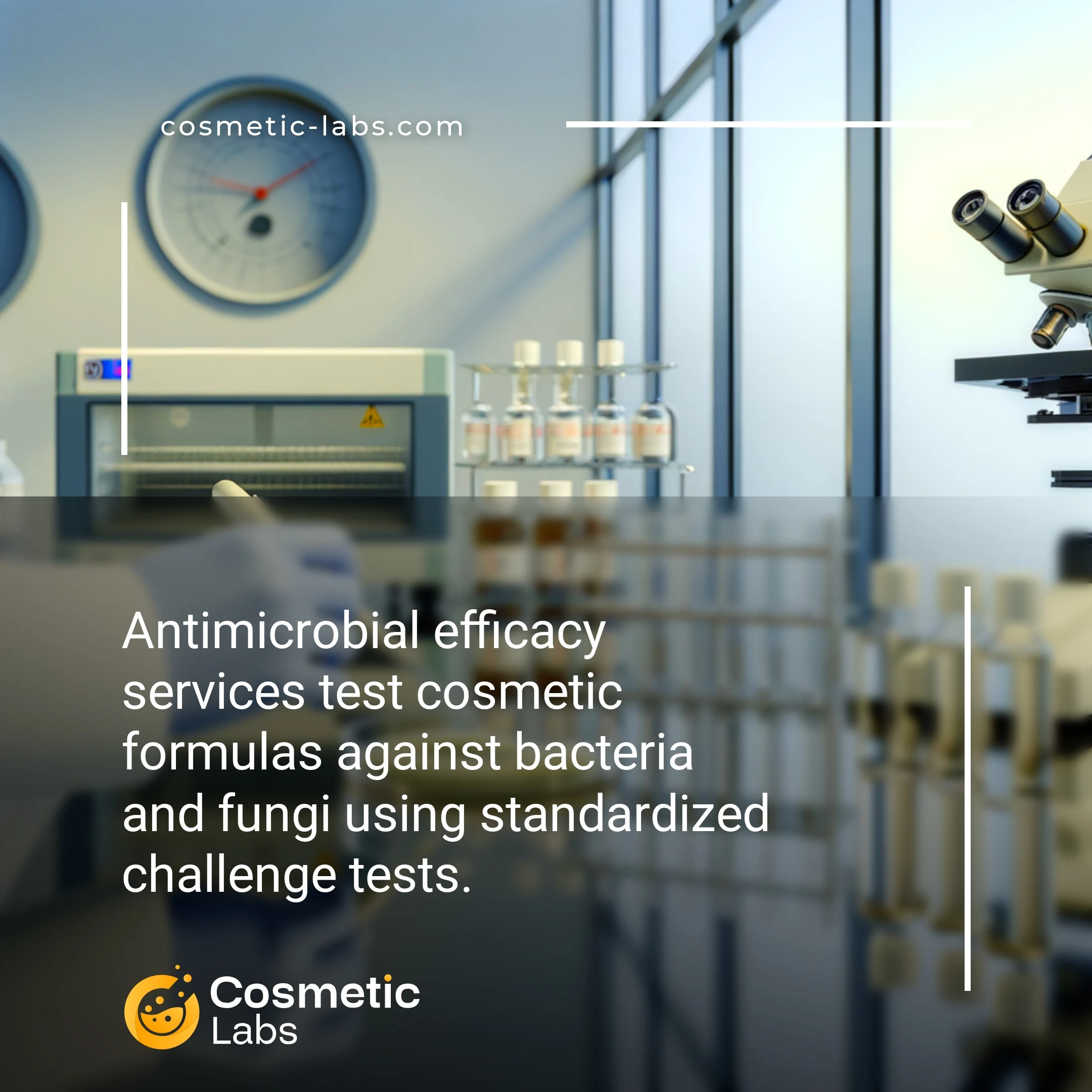Antimicrobial Efficacy Services for Reliable Cosmetic Product Testing

What is Antimicrobial efficacy?
Antimicrobial efficacy testing measures how well your preservative system protects cosmetic formulations against bacteria, yeast, and mold contamination. Labs challenge your product with specific microorganisms like E. coli and Candida albicans, then track reduction rates over 28 days to verify it meets ISO 11930 or USP 51 standards.
Why do you need this service?
Cosmetic labs apply antimicrobial efficacy testing to validate preservative systems in water-based formulations like serums, lotions, and micellar waters that face contamination risks. These services help brands meet regulatory requirements by demonstrating products resist microbial growth over their intended shelf life of 24-36 months, preventing costly recalls and protecting consumer safety.
Who provides Antimicrobial efficacy services?
All cosmetic labs providing Antimicrobial efficacy services
There is no company providing these services at the moment.
Antimicrobial Efficacy Testing Services
Antimicrobial efficacy testing validates that your cosmetic products resist contamination throughout their shelf life. Labs on our platform test your preservative systems against bacteria, yeast, and mold to meet regulatory standards and protect consumer safety.
Challenge Testing Methods
Professional labs perform preservative efficacy tests by introducing specific microorganisms into your product samples. They monitor microbial counts at set intervals—typically days 7, 14, and 28—to verify your preservative system works.
Standard test organisms include:
- Staphylococcus aureus and Pseudomonas aeruginosa (bacteria)
- Candida albicans (yeast)
- Aspergillus brasiliensis (mold)
- Additional organisms based on product type and market requirements
Labs follow ISO 11930 or USP 51 protocols, depending on your target markets. Results show whether your formula meets acceptance criteria for microbial reduction over time.
Real-World Stability Testing
Beyond standard challenge tests, labs assess how your products handle everyday contamination risks. They simulate consumer use by repeatedly opening containers and introducing low-level contamination.
This testing reveals whether your preservative system remains effective when customers dip fingers into jars or reuse applicators. Labs also test preservative performance at different pH levels and temperatures matching your product’s expected storage conditions.
Many facilities offer accelerated aging studies alongside antimicrobial testing. These combined results predict how well your products resist contamination throughout their intended shelf life—data you need for product labels and safety assessments.
Practical Applications of Antimicrobial Efficacy Testing in Cosmetic Development
Antimicrobial efficacy testing directly impacts product safety and shelf life across every cosmetic category from skincare to color cosmetics.
Water-Based Formulation Testing
Labs perform antimicrobial efficacy testing on emulsions, serums, and toners using USP 51 and ISO 11930 protocols. Testing identifies minimum preservative concentrations needed for 2-3 year shelf stability. For a typical face cream, labs inoculate samples with Candida albicans, Aspergillus brasiliensis, E. coli, P. aeruginosa, and S. aureus at 10⁶ CFU/g.
Results guide preservative system optimization. A lab might test phenoxyethanol at 0.5%, 0.75%, and 1.0% to find the lowest effective dose that achieves 3-log reduction within 7 days.
| Product Type | Common Test Organisms | Typical Test Duration | Pass Criteria |
|---|---|---|---|
| Face Creams | 5 standard strains + environmental isolates | 28 days | 3-log reduction (bacteria), 2-log (fungi) |
| Shampoos | P. aeruginosa, C. albicans, S. aureus | 14-28 days | No increase from initial count |
| Mascara | P. aeruginosa, S. aureus, C. albicans | 28 days | 2-log reduction within 14 days |
| Lip Products | S. aureus, E. coli, C. albicans | 28 days | No increase, 1-log reduction preferred |
Natural and Clean Beauty Preservation
Natural preservation systems require specialized testing approaches. Labs evaluate botanical extracts, ferments, and multifunctional ingredients through repeated challenge tests. A typical protocol tests rosemary extract combined with glyceryl caprylate against standard microorganisms plus brand-specific environmental isolates.
Testing includes synergy studies where labs combine 2-3 natural antimicrobials to achieve broad-spectrum protection. Results often show combinations like leuconostoc ferment (0.5%) plus glyceryl caprylate (0.3%) matching synthetic preservative performance in pH 5.0-6.5 formulations.
Ready to validate your preservative system? Connect with specialized labs on our platform for antimicrobial efficacy testing tailored to your formulation needs.